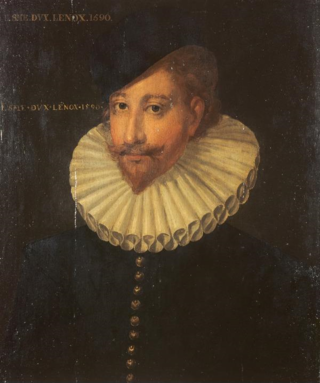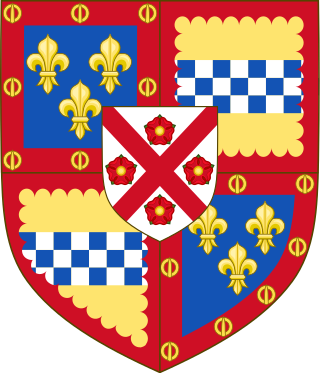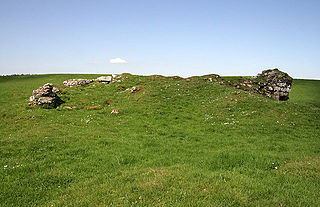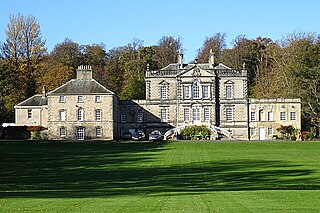Related Research Articles
Archibald Campbell, 5th Earl of Argyll was a Scottish nobleman, peer, and politician. He was one of the leading figures in the politics of Scotland during the reign of Mary, Queen of Scots, and the early part of that of James VI.
George Leslie, 4th Earl of Rothes was a Scottish nobleman and diplomat.

Esmé Stewart, 1st Duke of Lennox, 1st Earl of Lennox, 6th Seigneur d'Aubigny of the Château d'Aubigny at Aubigny-sur-Nère in the ancient province of Berry, France, was a Catholic French nobleman of Scottish ancestry who on his move to Scotland at the age of 37 became a favourite of the 13-year-old King James VI of Scotland. Esmé Stewart was the first cousin of James' father, Henry Stewart, Lord Darnley. Despite his conversion to Calvinism he was never trusted by the Scots and returned to France where he ended his days. Sir James Melville described him as "of nature upright, just and gentle". He was the first to popularise the firstname Esmé in the British Isles.
Patrick Ruthven, 3rd Lord Ruthven played an important part in the political intrigues of 16th century Scotland. He succeeded to the lordship in December 1552. The Ruthven lordship encompassed the offices of Provost and Constable of Perth, and Sheriff of Strathearn.

Andrew Leslie, 5th Earl of Rothes was a Scottish nobleman.

Sir James Hamilton of Finnart was a Scottish nobleman and architect, the illegitimate son of James Hamilton, 1st Earl of Arran, and Marion Boyd of Bonshaw. Although legitimated in 1512 while still a minor, he continued to be known as the "Bastard of Arran". As a key member of the Hamilton family, and second cousin of James V, King of Scotland, he became a prominent member of Scottish society.

James Douglas, 7th Earl of Douglas, 1st Earl of Avondale, latterly known as James the Gross, and prior to his ennoblement as James of Balvenie, was a late mediaeval Scottish magnate. He was the second son of Archibald Douglas, 3rd Earl of Douglas, and Joan Moray of Bothwell and Drumsargard, d. after 1408.

Lord Somerville is a title in the Peerage of Scotland which is subject to a number of ambiguities. The date of creation is not known with certainty but it was probably created about 1435 for Thomas Somerville, Justiciar of Scotland. The title was omitted in 1606 when an ordered list of the Scottish peerage was produced following the union of the Scottish and English crowns, and the title was not used during the 17th century. In 1723, however, the House of Lords ratified and acknowledged the title for James Somerville the 13th Lord. The consecutive numbers ascribed to the numerous Lords differ according to which authority is consulted. The list below uses the numbers favoured by Burkes Peerage.

John Stewart, 1st Earl of Lennox was a Scottish earl. He was known as Lord Darnley and later as the Earl of Lennox.
William Somerville, 2nd Lord Somerville was a member of the Scottish Parliament in the mid-15th century. He is the first person to have clearly held the title Lord Somerville, having been created such in 1445, although other sources suggest that his father was the first Lord.
John Somerville, 3rd Lord Somerville was the son of William Somerville, 2nd Lord Somerville and Janet Mowat. He was a member of the Scottish Parliament. In 1449 he fought with the Scots who defeated the English at Sark. He was also present at the siege of Roxburgh in 1460 during which James II of Scotland died.
Hugh Somerville, 5th Lord Somerville was a lord of the Parliament of Scotland. He is sometimes reckoned to be the 4th Lord Somerville. He succeeded his brother, John Somerville, 4th Lord Somerville. Hugh and John were sons of William Somerville, Master of Somerville, and Marjory Montgomerie.
John Somerville, 4th Lord Somerville, (c.1484-1523), was a Lord of the Parliament of Scotland.

Cowthally Castle, also known as Couthalley, is a ruined L-plan castle near Carnwath, Lanarkshire, Scotland. The remains are protected as a scheduled monument.
Sir Alan Stewart of Darnley, 2nd Lord of Concressault was a Scottish nobleman of the Stewart of Darnley family, involved in the Hundred Years War.
Sir Alexander Stewart of Darnley was a Scottish nobleman, and a patrilineal ancestor of James VI and I.

Sir James Steuart of Coltness was a Scottish merchant, banker, landowner, politician and Covenanter.

The Drum is an 18th-century country house and estate on the outskirts of Edinburgh, Scotland. Located between the Gilmerton and Danderhall areas, The Drum is 4 miles (6.4 km) south-east of the city centre. The Drum was the seat of the Lords Somerville from the later Middle Ages, who built a 16th-century house on the estate. This was replaced in the 1720s with a classical house by William Adam. Sold by Lord Somerville in the early 19th century, the house remains in private hands.
James Somerville (1632–1690) was a Scottish family historian. A youthful soldier of the Wars of the Three Kingdoms, he like his father declined to claim the title Lord Somerville, but wrote an extensive work on his ancestry, later edited by Walter Scott.

John Stewart, Commendator of Coldingham (1531–1563) was a Scottish landowner.
References
- ↑ Rhymer, Thomas, ed., Foedera, vol. 10, p. 301: Memorie of the Somervilles, vol. 1 (1815), 159 footnote, 164 footnote, 166-7.
- ↑ Somerville, James (1920). The Baronial House of Somerville. Glasgow: Maclehose. pp. 25–26. Retrieved 19 August 2016.
- ↑ Douglas, Robert (1764). The Peerage of Scotland. Edinburgh. p. 627. Retrieved 19 August 2016.
- ↑ Memorie of the Somervilles, vol. 1 (1815), 168-170 & footnote, 171 & footnote, 175, 176.